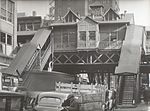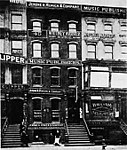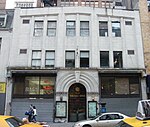Universal Hotel
1880s establishments in New York (state)Defunct hotels in ManhattanHistory of ManhattanManhattan building and structure stubs
Universal Hotel may refer to three different establishments of the late 19th century and early 20th century Manhattan, New York. There was a Universal Hotel at 352 Bowery. Another lodging, called Morgan's Universal Hotel, operated in New York City during the 1890s. It was located 75 Clarkson Street, currently the address of Mystique Gentleman's Club. A third establishment named Universal Hotel was located at 6th Avenue (Manhattan) and the northwest corner of 28th Street (Manhattan). It was altered in 1909, expanding to a five-story hotel and store. The alteration was performed by architect B.W. Devitan, at a cost of $15,000.
Excerpt from the Wikipedia article Universal Hotel (License: CC BY-SA 3.0, Authors).Universal Hotel
West 28th Street, New York Manhattan
Geographical coordinates (GPS) Address Nearby Places Show on map
Geographical coordinates (GPS)
| Latitude | Longitude |
|---|---|
| N 40.746 ° | E -73.9903 ° |
Address
West 28th Street 59
10001 New York, Manhattan
New York, United States
Open on Google Maps








